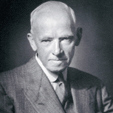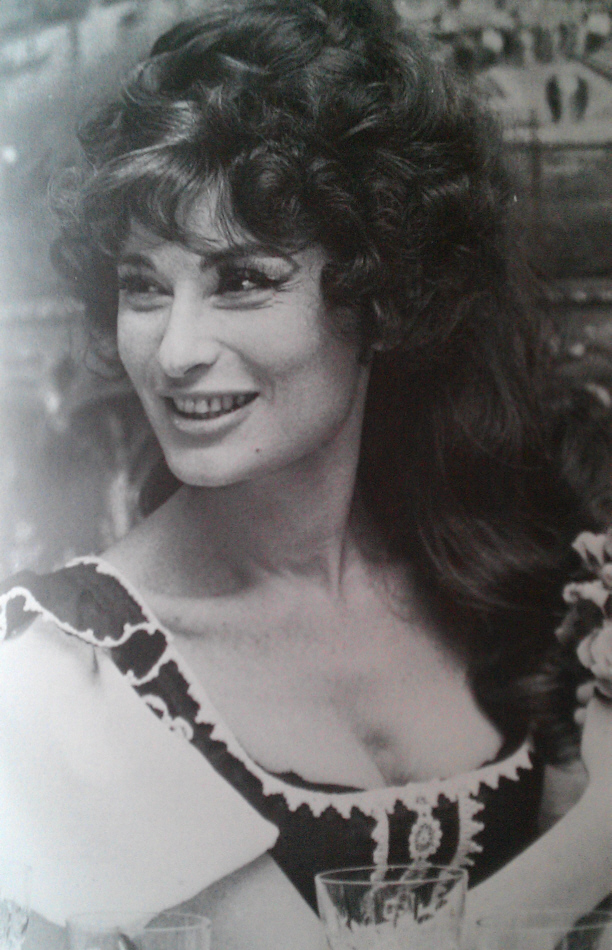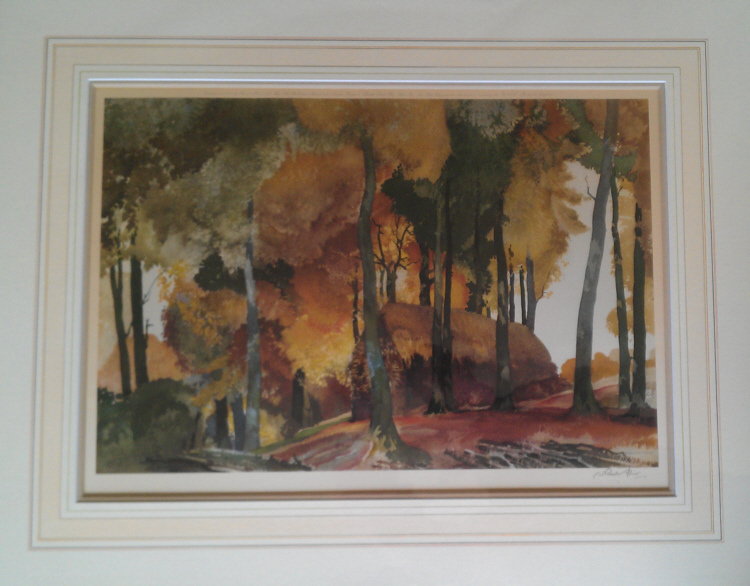



The Wood Rick
Signed, Limited edition of 325
Published 1942
Image Size 14.75" x 22".
The scene is at Great Englebourne, three miles south west of Totnes in the Devon hills, where he spent much of his time during the early
part of the '39-'45 War.
There is still a wood pile on the spot today, albeit a somewhat depleted one, and it is also to be seen from a different angle
in the tempera painting "Great Englebourne" which appears in "More than shadows" as Plate 90. Incidentally Plate 122 in that book
shows the same covert from a different angle; the "dovecote" wall is the left hand gable end of the coach-house in Plate 90.
The Englebournes (O.E. English Stream) are a series of isolated farmsteads of Saxon origin of which the chief was Great Englebourne.
Even today the buildings attendant on the superb Georgian mansion, the old Linhay, the Shippens, the Coach-house, have about them much
of the time worn air of usage that he sought and found in France.
"... I found much to delight men in Devon" he wrote "but somehow I feel more interest in French agricultural scenes.
The timberwork there is usually more massive, buildings are often adapted, not built for their present purpose.
There is more than a hint of primitiveness in the tools and outfit."
Even so there is much about this corner of Devon to appeal to the lover of old France.
One has only to wander the winding flower decked lanes of medieval Totnes on a sunny summer evening to be back in Viviers or La Voulte.
Outside the UK ++ 44 1623 799 309
![]() All major credit/debit cards accepted
All major credit/debit cards accepted

Sir William Russell Flint, was born in Edinburgh on the fourth of April Eighteen eighty.
His father Francis Wighton Flint, was a watercolourist and designer,
William Russell Flint was fortunate that his family was involved in artistic careers. He studied at Daniel Stewarts School,
and then joined the Royal Institution College of Artwork in Edinburgh, this was the environment that led him to work on line and colour
which progressed into his own unmistakable watercolour style.
His six year apprenticeship as a draughtsman at a large printing factory in Edinburgh, helped to cultivate the disipline required
to become an outstanding artist in his own right.
In 1903 Russell Flint began work at the Illustrated London News drawing illustrations.
This was the era before photos, a time where drawings and engravings have been the only source of illustration for books and magazines.

During this period and WW1, Russell Flint also produced illustrations for some great classic writings such as "Thomas a Kempis",
"The Song of Solomon", Mallory's "Morte d'Arthur", Chaucer's "Canterbury Tales" and Homer's "Odyssey".
Throughout the conflict, Flint was in the Royal Navy Air Service and by 1918 he was promoted to Admiralty Assistant Overseer;
He was able to travel back to Scotland where he studied at the art School.

1936 saw Russell Flint become the President of the Royal Society of Painters in Watercolour. Throughout the early 1940s, Russell and Sybil Flint went to live in Devon on a farm that reared poultry. Having served in the RAF, he was allowed to visit Devonport Dockyard,( of which a limited edition has been published, and was described as a masterpiece of perspective) and paint, whenever he wished.
In 1945 William Russell Flint and his wife Sybil returned to their home at Peel Cottage, Campden Hill, London. 1947 saw Russell Flint knighted and he painted throughout his life until the age of 89 when he died. His work as a professional artist spanned many years and he was later able to create a unique feel to his paintings that produced his most recognizable style. The paintings he produced were less rigid and he was able to show in exquisite detail, the different textures of materials, buildings, and of course, flesh.
Sir William Russell Flint has given and continues to give great joy to many individuals across the world.
His signed limited edition prints and original paintings, have become extremely collectable, and his work enjoys a great following
as some of the finest watercolour paintings in the world today.
He was a much liked architectural, watercolour artist, who was most famous for his paintings of female nudes.In the art world,
Russell Flint was a revered by his colleagues. His father was an industrial artist and as a boy he joined a lithographic company where he spent six years
learning about the printing industry and the many different techniques used. Russell Flint was born in Edinburgh, Scotland in eighteen hundred and eighty,
his gift for painting was soon impressing both his fellow artists and the general public.
During his student days at the Edinburgh Royal Institution Faculty of Artwork, and after working for six years at the lithographic printing company, he made the decision to live in London and work as an illustrator in the world of medicine, and then in 1903 he became an illustrator for the Illustrated London News which , due to worldwide distribution, publicised his work across the globe. In nineteen hundred and five he married an admiral's daughter, Sibylle Sueter in 1905 and his work continued to flourish so that two years later he was able to become a freelance artist which gave him the opportunity to illustrate several classical special editions for example; Mallory's 'Morte D'Arthur', Chaucer's 'Canterbury Tales' and Homer's 'Odyssey'.
During WW1 his job was the Admiralty assistant overseer of Airships . He returned to his birthplace of Scotland, and some years later painted a watercolour titled ' Hilda's Bonnet' on a small piece of material from HM Airship 24 which he had been in charge.
After the Geat War, Russell Flint's creative profession started to bloom. He travelled in France and Spain, the place he painted beautiful pictures showing the local landscapes and regional way of life.

In 1924 he was asked to join the Royal Academy as an associate member, and nine years laterhe was given the status of full member in 1933. Three years later he became President of the Royal Society of Painters in Watercolour. Leaving their home in Devon, where they had lived throughout the Great War, Russell Flint and Syblle decided to return to Campden Hill, London, which proved a tremendous success for Russell Flint as the nation was begining to recover from the years of war, and begining to enjoy the arts once more.
His expertise with the watercolour medium and his talent in painting nudes, created an unique manner of painting which became world famous.
William Russell Flint was made Sir William Russell Flint in nineteen forty seven, and fifteen years later his work was given supreme prominence by a retrospective exhibition in the Diploma Gallery of the Royal Academy. During this period, Charles Wheeler, who was the President of the Royal Academy, remarked that Russell Flint's art was an incredible feat and a 'baffling skill'.
In his later years, due to his artistic and financial success, Russell Flint was able to travel extensively across Europe, particularly in France
where he was a prolific painter, also enjoying some time painting in Switzerland, Spain, Italy, and Scotland.
Cornwater Fine Art has specialized in the paintings and prints of Sir William Russell Flint for over thirty years, and have on display over
500 edition prints, signed and unsigned; Also original watercolour paintings and red chalk drawings, for sale.
The limited edition prints, particularly the signed, limited edition prints (ie. pre 1969) were very sought after, and the entire edition could
be sold out within several hours of release.
There is no 'second' edition of these prints, these are the original signed, limited editions that have over the years become highly collectable and
sought after works of art, some of which are over seventy years old.